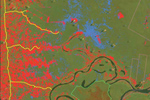For the first time, scientists have identified the areas of the Yucatan Peninsula that hold the highest concentrations of endangered woody plants, which includes trees, shrubs, and lianas. In doing so they uncovered four key regions, but also noted that the region with the highest concentration of extremely rare plants was left unprotected, according to a new paper in mongabay.com’s open access journal Tropical Conservation Science.
“This study represents the first effort for identifying the rare woody plant species of the Peninsula, estimating patterns of distribution of rare species richness and evaluating the current protection status of such species,” the researchers write.
Using records of 195 rare woody species, including 11 species found only in the Yucatan, the researchers were able to locate four geographical areas and lump them into three categories of rarity—low, medium, and high. Regions of low-to-medium rarity (Calakmul, Escárcega-Champotón, Quintana Roo-Oeste) were currently protected, but the region with the greatest concentration of the rarest woody plants, Panabá-Tizimín, has been left unprotected.
The authors urge that the Panabá-Tizimín requires swift conservation efforts.
CITATION: Tetetla-Rangel, E., Durán, R., Hernández-Stefanoni, J. L. and Dupuy, J. M. 2012. Distribución espacial de la riqueza de especies leñosas raras de la Península de Yucatán y su relación con las áreas naturales protegidas. Tropical Conservation Science Vol. 5(3):320-339.
Related articles
Indonesia, Brazil, Mexico, Peru get big boost in deforestation tracking, biomass measurement

(07/11/2012) Efforts to rapidly and accurately track deforestation and forest degradation in Indonesia, Brazil, Mexico, and Peru got a boost this week with a special technical training session organized by the Governors Climate and Forest Task Force. The meeting, convened at Stanford University and Google’s Silicon Valley campus, paired staffers from government agencies and NGOs in the four tropical countries with technical experts from the Amazon Environmental Research Institute (IPAM), the Carnegie Institution for Science, the Forum on Readiness for REDD, Woods Hole Research Center, and Google Earth Outreach. The participants received training to augment existing deforestation, forest degradation and biomass monitoring capabilities, which are highly variable both between countries and within sub-national agencies and jurisdictions.
Making reforestation work in abandoned pasturelands
(07/09/2012) Tropical reforestation is not easy, especially in abandoned pasturelands. But a new study in mongabay.com’s open access journal Tropical Conservation Science finds that removing grasses prior to and after planting native tree seeds significantly improves the chances of forests to take root. The study site, located in Mexico’s Lacandon rainforest, was covered in an invasive African grass (Cynodon plectostachyus).
Mexico passes aggressive climate bill

(04/23/2012) Last week, Mexico’s Senate passed an aggressive and comprehensive climate change bill, making it the first developing nation and only the second country to do so, after the UK. The bill, which far outshines anything achieved by its far wealthier northern neighbors, sets ambitious targets for cutting emissions while creating new incentive programs for clean energy. Largely dependent on fossil fuels, Mexico is approximately the 11th highest greenhouse gas emitter in the world.
Cloud forests may be particularly vulnerable to climate change
(03/26/2012) Mexico could lose nearly 70 percent of its cloud forests due to climate change by 2080, according to new research published in Nature Climate Change, that has implications for cloud forests worldwide.







